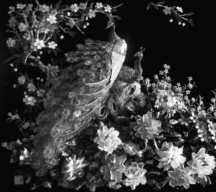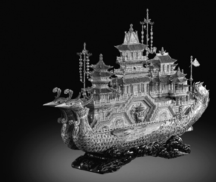Exquisite art coaxed out of its shell
Skilled Dalian craftsman, 79, transforms 'gift from the ocean' into beautiful paintings, sculptures, Deng Zhangyu reports.

Sitting in front of a cutting wheel in his studio full of seashells, artisan Jin A'shan takes a few pieces, fashions them into different shapes and quickly polishes them. Within minutes, ordinary abalone shells are magically transformed into pink flower petals and colorful peacock feathers.
Jin has devoted nearly 60 years to shell carving, doing the same things day after day, including designing, carving, grinding and polishing the shells.
"Shell carving is my life. I love it," says the 79-year-old in his studio in Dalian, a coastal city in Northeast China's Liaoning province.
Boxes of shells are piled up in his studio, along with half-finished works, such as shell paintings and sculptures. Walking out of his studio, a wondrous world reveals itself — a museum housing Jin's shell works, many of which are large and shimmer with a luster unique to shells.
The finger-sized shell petals Jin produces make up the thousands of components of his larger sculptures, such as qilin (a mythical creature representing good fortune and safety), dragons, and ships several meters in length. Many of his works have been collected and exhibited by major museums across China.
"Humans started shell carving thousands of years ago. They were used in daily life for decoration. With the improvement of carving tools, I can make them into artworks of paintings and sculptures," says Jin.
Standing in the central hall of the Shell Carving Art Museum is a smaller version of a wall replicating the Nine-Dragon Wall in Beihai Park in Beijing. All the nine dragons carved into the wall, together with hundreds of smaller ones of varying colors, are made from seashells.
Creating the wall took Jin and his team two years to complete, with more than 10 craftsmen involved in the project.
Two colorful shell qilin stand next to the wall, with both inspired by the qilin in Beijing's Forbidden City.
Apart from dragons and qilin, the red-crowned crane is also a subject Jin loves to produce. All these creatures are regarded as auspicious animals from ancient Chinese times. "I prefer to find inspiration and stories from traditional Chinese culture," says Jin.
Golden peacock
Jin was born into a wealthy family and his grandmother taught him about culture, especially Chinese ink painting, and he is good at depicting birds and flowers, popular themes of such work.
"To make good shell carvings, I had to master various skills, including painting, calligraphy, sculpture and carving. Besides, it consists of more than 10 complicated processes," adds Jin.
Jin was nicknamed "golden peacock" by his friends because he was so good at painting and making shell peacocks, a subject he has continued producing.
To make colorful artworks, Jin has gathered shells from across the world. Abalone pieces from Australia, the United States and Canada are widely used in his works.
"It's common for me to use millions of shells for one work. I don't know exactly how much material I use, but I do know what I can make when I see a shell for the first time," Jin says, laughing.
When seeing and touching these little gifts from the ocean, Jin can quickly make a decision on what they can be turned into based on their shape, color and thickness.
He still works 10 hours a day in his studio. "The secret to honing good skills is time and practice. I have spent all my lifetime on it," says Jin.
He says he can sit in front of the cutting wheel without drinking water for four or five hours, a habit he developed from the age of 20, when he became a shell carver at a factory.
"In the 1960s, to find a job was very difficult when China was poor. I valued my job very much, and I told myself I must give all my time to it," explains Jin on his work ethic.
The shell decorations and designs of shells produced at the factory Jin worked at were in high demand, and most were exported overseas.
In the 1980s, shell painting became very popular in Dalian, where the craft can be dated back to the Han Dynasty (206 BC-AD 220), according to discoveries at archaeological sites.
After the factory closed down in the 1990s due to the items' waning popularity, Jin started making his own shell artworks.
Gem of an idea
"I made innovations to shell-carving techniques and added precious gems, gold and jade to the shell carvings. That's why many people bought my works," Jin says.
With the development of technology, shell carvings have become more delicate and exquisite.
"In ancient times, a craftsman could probably only make two or three pieces of shell carvings in a lifetime due to the limitations of the tools," says Jin.
Now, with the help of tools such as power rotary cutters and wheels, Jin can make shell art of less than 1 centimeter.
His two shell ships featuring Chinese architecture took two years to finish and have won many awards. A 1-cm shell lantern placed on one ship took him a day to produce by hand.
"Machines can't make the same circular lantern as mine. That's the charm of work made by craftsmen," he says proudly.
Jin is now an inheritor of the intangible cultural heritage of shell carving. He has also inherited the same problem that many other traditional craftsmen now face — how to protect and pass on his skills to the younger generation.
This year, he cooperated with Dalian Art College to set up a training session for young students interested in the craft.
"The problem is that few young people can sit down for hours doing the same thing. It's kind of boring for them at a time when their lives are bombarded by online entertainment," he says.
Jin's son Jin Ji has learned shell carving from his father for decades. "The craft has successfully passed down in our family. My son also plans to enter into this course," says Jin Ji, whose son is a college student.
Jin Ji says his father seems to have no other interest other than shell carvings. But once the gray-haired artist begins working, he turns into a child.
"My father loves his career and it also makes him happy and young in his thoughts," says Jin Ji.
Zhang Xiaomin contributed to this story.





Today's Top News
- China remembers victims of Nanjing Massacre, 88 years on
- New plan will be a road map for a stronger future
- Taiwan's character of the year a vote against confrontation
- Strengthened resilience key for economy
- Video sheds new light on Japan's wartime atrocities
- Xi: World yearns for peace, trust more than ever






























